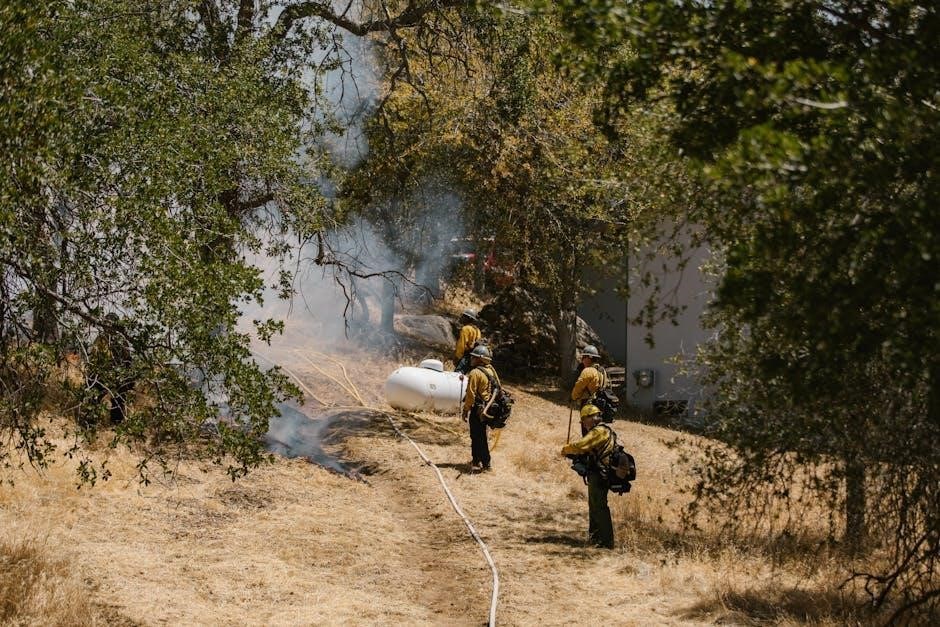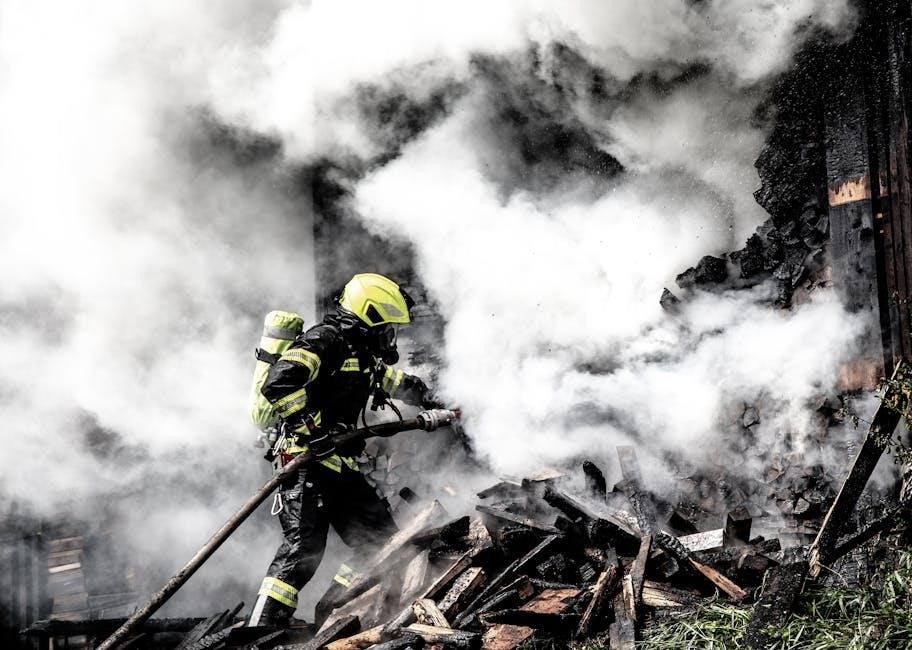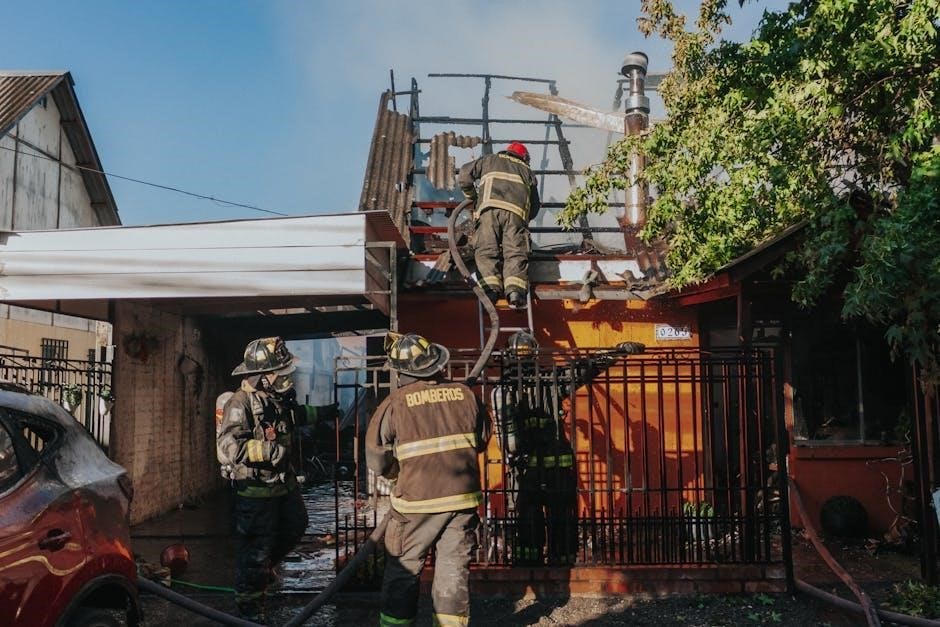The NFPA 101, Life Safety Code, is a critical standard for ensuring safety in buildings from fire and related hazards. It provides minimum requirements to safeguard life and health, addressing means of egress, fire protection, and emergency conditions. Developed by the National Fire Protection Association, it is widely adopted across the U.S. and regularly updated to reflect advancements in safety practices.
Purpose and Scope of the Life Safety Code
The NFPA 101 Life Safety Code establishes minimum requirements to ensure the safety of occupants in buildings from fire and related hazards. Its purpose is to safeguard life by addressing means of egress, fire suppression, emergency lighting, and occupancy loads. The scope applies to both new and existing structures, providing comprehensive guidelines for design, installation, and maintenance of life safety systems. It emphasizes protecting occupants during emergency conditions, including fires, earthquakes, and hazardous material incidents. The code is widely adopted across jurisdictions and is regularly updated to reflect modern safety practices, ensuring it remains a cornerstone for fire and life safety in buildings worldwide.
Historical Development of NFPA 101
The NFPA 101 Life Safety Code traces its origins to the early 20th century, emerging from the Committee on Safety to Life established by the National Fire Protection Association in 1913. This committee aimed to address growing fire safety concerns in buildings following significant fires that highlighted deficiencies in existing regulations. The first edition of the Life Safety Code was published in 1927, focusing on egress requirements and means of escape. Over the years, the code has evolved through periodic updates, incorporating new technologies and lessons learned from major incidents. Today, it remains a foundational document for ensuring occupant safety in buildings across diverse occupancies and hazards, reflecting a century of advancements in fire and life safety practices.

Key Provisions of NFPA 101
NFPA 101 establishes requirements for egress systems, fire suppression, emergency lighting, and occupancy loads, ensuring comprehensive safety measures for various occupancies and building types.
Egress Requirements and Means of Escape
NFPA 101 mandates clear exit pathways, illuminated exit signs, and emergency lighting to ensure safe evacuation. Stairwells must allow re-entry from roofs, with doors possibly locked but ensuring accessible escape routes. Compliance ensures reliable egress systems during emergencies.
Fire Suppression and Alarm Systems
NFPA 101 requires fire suppression and alarm systems to be designed, installed, and maintained in accordance with specific standards. These systems must provide early detection and notification of fires, ensuring timely evacuation and response. Automatic sprinkler systems are mandated in high-risk areas, while smoke detectors and pull stations are essential for rapid alert systems. Regular testing and inspection of these systems are critical to ensure reliability during emergencies. Integration with building management systems enhances monitoring and response capabilities, aligning with NFPA’s commitment to safeguarding lives and property through advanced fire protection measures.
Emergency Lighting and Signage
NFPA 101 mandates that emergency lighting and signage systems must be installed to ensure safe evacuation during power outages or emergencies. These systems are critical for maintaining visibility and directing occupants to exits. Exit signs must be clearly illuminated, with letters and arrows in high-contrast colors, and must be visible from any point in the building. Emergency lighting should provide a minimum illumination level, ensuring that escape routes remain visible. Backup power sources, such as batteries, are required to ensure functionality during failures. Regular testing and inspection of these systems are necessary to maintain compliance, while clear design and placement guidelines ensure effectiveness in all building types and layouts.
Occupancy Load and Crowd Management
NFPA 101 establishes guidelines for occupancy load and crowd management to prevent overcrowding and ensure safe evacuation. The code provides occupancy load factors based on the building’s use, calculated using floor area per person. Aisles, exits, and seating arrangements must be designed to accommodate the maximum number of occupants. For assembly spaces like stadiums or theaters, crowd managers are required to oversee emergency procedures. The code also specifies signage and markings to ensure clear paths for egress. Compliance with these provisions helps mitigate risks associated with large gatherings, ensuring that all occupants can exit safely during emergencies. Regular updates reflect evolving safety standards.

Compliance and Enforcement
NFPA 101 requires regular inspections and testing of safety systems to ensure adherence to standards. Local authorities enforce compliance, with penalties for non-compliance. This ensures occupant safety.
Inspections and Testing Requirements
Regular inspections and testing are essential for compliance with NFPA 101. Fire suppression systems, alarms, and emergency lighting must be inspected quarterly and tested annually. All means of egress, including exits and stairways, must be inspected monthly to ensure they remain unobstructed and functional. Testing of fire dampers, smoke barriers, and fire door assemblies is also required to maintain their integrity. Documentation of all inspections and tests must be maintained, and any deficiencies must be corrected promptly. These requirements ensure that safety systems remain reliable and functional, protecting occupants in emergency situations. Non-compliance can result in enforcement actions by local authorities.
Role of Local Authorities in Enforcement
Local authorities play a crucial role in enforcing compliance with NFPA 101. They are responsible for conducting regular inspections to ensure buildings meet the code’s requirements, including fire safety systems, means of egress, and emergency lighting. Authorities review plans for new constructions and renovations to verify compliance before issuing permits. They also address violations and enforce corrective actions to maintain public safety. Local jurisdictions may adopt NFPA 101 with additional amendments tailored to their specific needs. By upholding these standards, local authorities help protect occupants from fire and other life-threatening emergencies, ensuring a safer built environment for communities.
Applications and Use Cases
NFPA 101 applies to various occupancies, including residential, commercial, and industrial buildings. It ensures safety in high-rise structures, special venues, and assembly occupancies, providing adaptable solutions for diverse environments.
Residential Buildings and Apartment Complexes
NFPA 101 provides essential safety guidelines for residential buildings, including apartment complexes, ensuring occupant safety from fire and other emergencies. It outlines requirements for means of egress, emergency lighting, and fire suppression systems tailored to residential occupancies. The code addresses occupancy load factors, stairway access, and evacuation routes, ensuring safe exit during emergencies. Specific provisions for apartment buildings include smoke alarms, fire-resistant construction, and access for emergency responders. Compliance with NFPA 101 helps prevent fire-related hazards and protects residents in multi-family dwellings. Local jurisdictions often adopt these standards, adapting them to regional needs while maintaining core safety principles.
Commercial and Industrial Facilities
NFPA 101 establishes comprehensive safety standards for commercial and industrial facilities, ensuring the protection of occupants, employees, and assets. The code outlines requirements for fire suppression systems, emergency alarms, and means of egress tailored to these environments. Specific provisions address high-rise offices, retail spaces, and industrial warehouses, focusing on fire resistance, emergency lighting, and signage. Crowd management and occupancy loads are carefully regulated to prevent hazards in densely populated commercial areas. The code also mandates regular inspections and maintenance of safety systems, ensuring compliance and readiness for emergencies. By adhering to NFPA 101, businesses can mitigate risks and create a safer environment for everyone.
High-Rise Buildings and Special Structures

NFPA 101 includes specific provisions for high-rise buildings and special structures, addressing unique safety challenges. For high-rises, the code mandates enhanced fire protection systems, pressurized stairwells, and elevator shaft protection to ensure safe evacuation. Smoke management systems and emergency communication are also emphasized. Special structures, such as stadiums or atriums, require adaptive safety measures tailored to their design. The code ensures that these buildings maintain occupant safety through detailed fire resistance ratings and egress pathways. Regular inspections and system testing are crucial to uphold safety standards in these complex environments, ensuring compliance with NFPA 101 and safeguarding against potential hazards.
Jurisdictional Adoption

NFPA 101 is widely adopted by state and local jurisdictions, often with amendments to address regional needs. Jurisdictions incorporate the code into their laws, ensuring compliance with its safety standards while allowing for local adaptations to specific risks and building types.
State and Local Amendments to NFPA 101
NFPA 101 serves as a foundation for state and local codes, with jurisdictions often adding specific amendments to address regional needs. For instance, states like Florida, Georgia, and Maryland incorporate the code while tailoring provisions to local risks. These amendments may include unique requirements for high-rise buildings, crowd management, or climate-specific safety measures. Local authorities ensure compliance by integrating NFPA 101 into their regulatory frameworks, balancing customization with the code’s core safety objectives. This adaptability allows jurisdictions to maintain the code’s integrity while addressing local challenges, ensuring comprehensive safety standards across diverse environments.
Training and Resources
NFPA offers comprehensive training programs, handbooks, and digital resources to help users understand and comply with the Life Safety Code. These tools provide expert guidance and practical strategies for implementing safety measures effectively.
Available Training Programs for Compliance
The NFPA offers a variety of training programs to help professionals understand and implement the Life Safety Code. These include online courses, workshops, and certification programs designed for facility managers, safety officers, and architects. The training covers key aspects of NFPA 101, such as means of egress, fire suppression systems, and emergency lighting. Additionally, NFPA provides access to handbooks, webinars, and interactive tools to enhance learning. These resources ensure that participants gain practical knowledge to maintain compliance and improve safety in residential, commercial, and industrial settings. The programs are regularly updated to reflect the latest code revisions and advancements in fire safety technologies.
Access to NFPA 101 PDF and Digital Resources
Access to the NFPA 101 Life Safety Code is available in digital formats, including PDF and eBooks, through the official NFPA website. The document can be downloaded or purchased directly from the NFPA store, ensuring users have the most up-to-date edition. Additionally, NFPA offers free online access to its standards for public review, though full access requires purchase. Digital resources include the NFPA 101 Handbook, which provides expert commentary and visuals to aid in understanding and compliance. These resources are essential for professionals seeking to implement safety measures effectively and stay informed about the latest code updates and interpretations.

Future Trends in Life Safety
Future trends in life safety emphasize smart building technologies, IoT integration, and sustainability. NFPA 101 updates will reflect these advancements, enhancing emergency response and monitoring capabilities.
Emerging Technologies and Code Updates
Emerging technologies are reshaping life safety standards, with NFPA 101 incorporating advancements like smart building systems and IoT devices. These technologies enhance fire detection, monitoring, and evacuation processes. Updates to the code now address integration with building information modeling (BIM) for improved compliance during construction. Additionally, renewable energy systems, such as solar panels and battery storage, are being considered to ensure safety during emergencies. Data analytics and AI are also being explored to predict potential risks and optimize evacuation routes. These updates reflect the NFPA’s commitment to adapting to modern challenges while maintaining stringent safety standards for all occupancies.

Leave a Reply